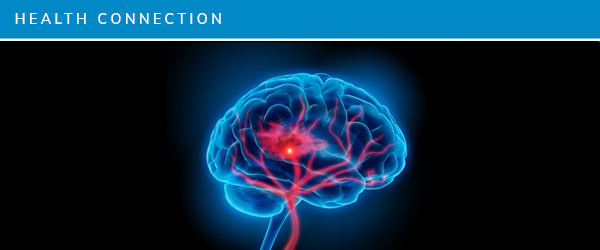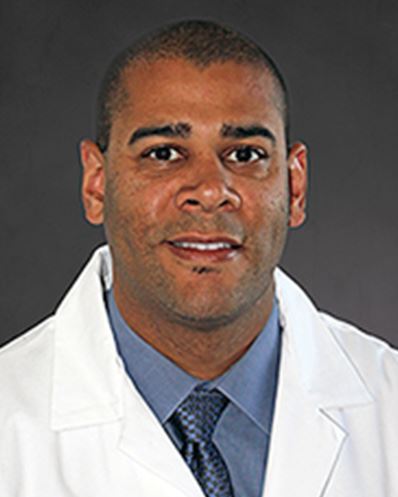Health Connection - May 2022

Stroke - What Everyone Needs to Know

A common analogy used to explain stroke compares the arteries to home plumbing. If you pour grease down the drain, it eventually clogs your pipes. In an ischemic stroke, arteries are clogged by plaque buildup or a blood clot, blocking blood flow to the brain. Hemorrhagic stroke is more like a burst pipe: a thin or malformed blood vessel called an aneurysm ruptures and bleeds into the surrounding brain tissue, just as a broken pipe leaks water. 87% of strokes are ischemic. The other 13% are hemorrhagic. In an ischemic stroke, the brain is damaged due to lack of oxygen. In a hemorrhagic stroke, the damage is compounded by pressure from the brain bleed on surrounding tissues. Either way, it’s essential to call 911 and get to the emergency department immediately.
The sooner stroke treatment can begin, the better the outcome. That’s why physicians say, “time is brain.” The most common treatment for ischemic stroke is the use of the clot dissolving medication tPA. The standard window for effectively administering tPA is 3 hours, but it has been used with some success as late as 4.5 hours after the onset of a stroke. In some cases, a large clot can be removed with a minimally invasive catheter-based procedure called a thrombectomy.
Treatment is different in the case of hemorrhagic stroke in which the problem is bleeding. When this type of stroke occurs near the skull, blood can pool in the space between the brain and the skull, causing swelling that can damage brain tissue. Pooled blood can also cause damage if the stroke occurs deeper in the brain. When possible, such strokes are treated surgically through an open procedure known as a craniotomy. The craniotomy alleviates pressure on the brain and provides access to the affected blood vessel if it can be surgically repaired. Learn more about stroke treatment at MarinHealth Medical Center – a Designated Primary Stroke Center.
Ultimately, the best treatment for stroke is prevention, by following the measures listed below. Even if you have already had a stroke, taking these preventive measures can help avoid a recurrence:
- Control your blood pressure—monitor it frequently and take your medication as directed.
- Limit your intake of fats, salt, and sugar and take statins as prescribed.
- If you have Atrial Fibrillation (AFib) be sure to take your blood thinners.
- If you are overweight, ask your doctor to recommend a weight-loss program.
- Exercise regularly. If you don’t work out, ask your doctor about the best way to safely start an exercise program.
- Don’t smoke and limit your alcohol consumption to no more than one drink a day for women and two for men.
- Monitor and control your blood sugar carefully if you have diabetes or prediabetes.
Know the Signs of Stroke!
If you recognize the signs of stroke in yourself or someone else, BE FAST in getting them help!
- B is for balance. Does the person have a sudden loss of balance or coordination?
- E is for eyes. Has the person lost vision in one or both eyes, or are they experiencing dramatic vision changes?
- F is for face. Does the person's face look uneven? Ask them to smile. Look for facial droop or a lopsided grin.
- A is for arm. Is one arm hanging down? Have the person close his/her eyes and hold both arms out with palms facing up. Look to see if one arm drifts down. Ask if the person is experiencing numbness, weakness, or tingling, or if they are unable to move an arm or leg.
- S is for speech. Is the person's speech slurred? Are they having trouble understanding you? Check to see if the person has trouble speaking, seems confused, or is not able to talk at all.
- T is for time. Remember, time is brain. It is essential that you call 911 and get the stroke victim to the hospital immediately! If possible, note the time the symptoms started, or the last time the person was known to be well. This is important information for the medical team treating the patient. If you are the one having the stroke symptoms do not drive yourself! Call 911 and unlock your door so the paramedics can let themselves in.
Learn more about stroke, including causes, risks, symptoms, prevention, treatment, and more by downloading our free, comprehensive stroke guide.
Melanie Lising, MD is a board certified neurologist at MarinHealth Neurology | A UCSF Health Clinic.
Blood Pressure Management: A Key Part of Wellness
Blood pressure measures the force blood exerts on the walls of your blood vessels. If you have high blood pressure, your heart needs to pump extra hard. Over time, this puts you at risk for heart disease and stroke. High blood pressure is also linked to kidney disease, aneurysms, eye damage, sexual dysfunction, and other conditions. Because high blood pressure does not cause symptoms, it is known as a “silent killer,” second only to smoking as a cause of preventable heart disease and stroke deaths.
High blood pressure is the most common risk factor for stroke and heart disease. In addition, more than 50% of hypertensive patients have one or more other cardiovascular risk factors, such as:
- Diabetes
- Elevated LDL-cholesterol and triglycerides
- Overweight/obesity
- Too much uric acid in the blood (Hyperuricemia)
- Metabolic syndrome – a combination of conditions that increase the risk for cardiovascular disease
- Unhealthy lifestyle choices such as smoking, high alcohol consumption and lack of exercise
Blood Pressure Guidelines
Blood pressure is measured with two numbers. The first number, systolic pressure, is the maximum pressure your heart exerts when it beats. The second number, diastolic pressure, measures the maximum pressure in your arteries between heartbeats. In 2017, the American College of Cardiology and the American Heart Association released new guidelines for high blood pressure, or hypertension. The guidelines are as follows:
- Normal is 120/80 or less
- Pre-hypertension is 120-139 over 80-89
- Stage 1 high blood pressure is 140-159 over 90-9
- Stage 2 high blood pressure is 160 and above over 100 and above
By lowering the threshold for high blood pressure, the updated guidelines stress the need for early intervention to keep blood pressure under control. This has resulted in diagnostic and prescriptive changes:
- Before 2017, , 32% of the U.S. adult population was considered to have high blood pressure; the 2017 guidelines push this number up to 46% -- nearly half the population
- 14% more people are now diagnosed with high blood pressure and counseled about lifestyle changes
- Medication is not recommended for Stage I hypertension unless a patient has already had a cardiovascular event or is at high risk of heart attack or stroke based on age and other health factors
- Socioeconomic status and psychosocial stress are risk factors for high blood pressure that should factor into a patient’s care plan
Hypertension is not a normal part of aging. If your blood pressure is above normal range (anything above 80/120), talk to your doctor. Depending on your numbers, you may need medication, or you may be able to manage your blood pressure with diet and lifestyle changes, such as eating more fruits and vegetables, reducing your consumption of bad fats and sodium, managing stress, increasing your level of activity and losing weight if necessary.
How to Dependably Monitor Your Own Blood Pressure
It’s important to monitor your blood pressure at home. Blood pressure fluctuates and levels should be based on an average of 2-3 readings on different occasions. Combining regular home readings with readings at your healthcare provider’s office can help identify the following:
- White coat hypertension, in which blood pressure is elevated in a medical setting but not in everyday life. People with white coat hypertension feel stressed during a doctor visit, which temporarily raises their blood pressure. They do not have the same level of elevated a heart disease risk as those with sustained high blood pressure.
- Masked hypertension, in which blood pressure is normal at the doctor’s office but elevated at home. People with masked hypertension may have stressors at home or at work that they don’t experience in the doctor’s office. Their heart disease risk may be similar that of people with sustained high blood pressure.
Blood Pressure Monitoring Tips
- Select a monitor that the American Medical Association recognizes as validated for clinical accuracy. You can find a list of these here.
- Don’t smoke, drink caffeinated beverages, or exercise within 30 minutes of taking your blood pressure.
- Empty your bladder and relax quietly for at least five minutes before you take your blood pressure.
- Sit with your back straight and supported on a hard backed chair. Keep your feet flat on the floor and don’t cross your legs. Place your bare arm on a table next to you with your upper arm at heart level―don’t take measurements over clothing. Place the bottom of the cuff directly above the bend in your elbow. Check your monitor's instructions for an illustration or have your healthcare provider show you how.
- Take multiple daily readings at the same time each day, such as morning and evening, and record the results. Each time you measure, take two or three readings one minute apart and record the results. If your monitor has built-in memory to store your readings, bring it to your medical appointments.
Managing your blood pressure is one important way to reduce your risk of heart attack. Learn more about other ways to improve your heart health by subscribing to our free Healthy Heartbeat series, which is packed with the latest information and lots of practical advice to keep you and your loved ones healthy.
Understanding Hernia Repair

A hernia is a hole or defect in the abdominal wall. The actual defect is not in the muscle but in the fascia, the thin casing of connective tissue that holds our muscles and organs in place. Surgery is the only effective treatment for hernia. People sometimes delay surgery for small, asymptomatic hernias. Surgery is necessary for small hernias that cause pain and discomfort and larger hernias that impact the strength and integrity of the abdominal wall. If tissue becomes stuck in a hernia, this is known as a “strangulated hernia.” Strangulated fat tissue can cause discomfort, but it is not life-threatening. A strangulated intestine, however, requires immediate emergency surgery.
There are several types of hernias, but the most common are umbilical, (behind the belly button), and inguinal, located in the groin area, or the scrotum in men. Some risk factors for developing or aggravating a hernia include obesity, heavy lifting, chronic constipation, smoking, and chronic coughing. Pregnancy can exacerbate smaller hernias.
Hernia repair can be performed as open surgery or minimally invasively either laparoscopically or robotically. The approach depends on the size of the hernia, the physician’s recommendation, and the patient’s preferences. The procedure involves sewing the torn fascia back together and, often, strengthening the repair with a patch of surgical mesh, using sutures, tacks, or surgical glue. Over time, tissue grows into the holes in the mesh, strengthening the site of the hernia. For hernias smaller than one centimeter, mesh is often not needed. Without mesh, a hernia of two centimeters or more has a higher recurrence rate. All the types of surgical mesh in use today are safe, reliable, and well-tolerated.
Both laparoscopic and robotic surgery can be used to repair an umbilical hernia. Compared to laparoscopy, which uses one high-definition camera, the robot uses two, with 10 times the visual acuity, plus 3D imaging. The “wristed” robotic arms can move in seven different directions, allowing for exceptional surgical accuracy. For inguinal hernias, traditional open repair can be just as effective as laparoscopic or robotic surgery.
Hernia surgery is performed in a hospital such as MarinHealth® Medical Center or surgical center. A broad spectrum of anesthesia can be used, depending on the type of procedure. Unless the hernia is very large and involves reconstruction, or the procedure was a medical emergency due to a strangulated intestine, most patients can go home the same day.
Give Your Children a Healthier Future by Vaccinating Against Cancer

When you think about what causes cancer, the first thing that pops into your head is probably smoking. You may also be aware of the risks of a high-fat, low-fiber diet, alcohol dependency, or exposure to carcinogenic chemicals. But did you know that roughly 45,400 new cancers diagnosed each year are linked to the human papillomavirus (HPV)?
The most common HPV-associated cancer is cancer of the cervix, but the virus is also linked to cancers of the vulva, vagina, penis, anus, and oropharynx (back of the throat, tongue, and tonsils). While smoking and alcohol consumption are also implicated in oropharyngeal cancers, HPV is thought to be the cause of 70% of such cancers in the United States. In fact, HPV-positive oropharyngeal cancer is rising swiftly among white men in the US. Thanks to the development of the Gardasil vaccine, parents now have the ability to protect their children from developing these cancers in adulthood.
An estimated 79 million people in the United States are infected with HPV. In fact, genital HPV is the most common sexually transmitted infection in the US. According to the Centers for Disease Control and Prevention (CDC), 80% of sexually active people will become infected with the virus at some point during their lives―at least four out of every five women by age 50 as well as an as-yet undetermined number of men. Because HPV often has no symptoms, most people with HPV don’t even know they have it. There is no treatment for an HPV infection.
While one’s immune system usually clears up HPV within a couple of years, the infection sometimes lingers, and can cause precancerous changes known as dysplasia. If these abnormal cells aren’t found and removed, they can become cancerous. About 10% of women with a cervical HPV infection develop long-lasting HPV infections that can lead to cervical cancer.
Gardasil 9 is the only vaccine that helps protect your son or daughter against nine different strains of HPV that can cause cancer in adulthood. That’s why the CDC recommends vaccinating both boys and girls around age 11 or 12, when they are scheduled for inoculation against meningococcal disease and tetanus, diphtheria, and whooping cough. The HPV vaccine is recommended by numerous groups, including the American Cancer Society, the American Academy of Pediatrics, the American Academy of Family Physicians, and the American College of Obstetricians and Gynecologists.
Receiving the Gardasil vaccine at 11 or 12 protects the child before teen years, when sexual experimentation is common. The HPV virus can be transmitted through sexual contact of many kinds—actual intercourse is not necessary for transmission. To your son or daughter, the Gardasil vaccine is just another shot the doctor needs to give them. To you, it’s an insurance policy that will protect your child from certain cancers for the rest of their life.

